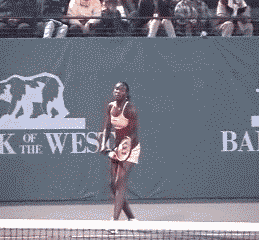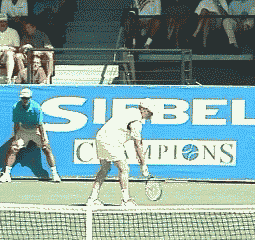|
TennisOne Lessons Hitting Up on the Serve What About Your Head? by Jim McLennan We have been through a number of articles on the serve. Teaching in Reverse looked at the role of the elbow and forearm. Dart in the Ceiling is meant to picture a quick forceful and upward extension of the tricep, much like throwing a dart in the ceiling. Unscrew the light bulb is meant to clarify the how when where and how much the forearm turns the racquet into the hit at the top of the swing. Working back from the ground up, pushing on the ground from a balanced and centered stance enables a forceful "dual leg drive". And finally the cartwheeling is meant to capture the rotation of the shoulders up and into the hit.
But through this entire action there is always the question of timing. Where is the hitting arm when the legs push against the ground? How are the shoulders positioned as they begin to turn up and into the hit? Where is the elbow when it extends the forearm up and into the hit? And of real importance here, in which direction is the body moving at contact? In the past few months I have been working with a special software program Silicon Coach (SC). SC enables multiple side by side comparisons of different servers, the software synchronizes the multiple images to the point of contact, so when run side by side one can compare your serve with Roger Federer's or any other players'. At our club I am using Jon Wong, an old friend and member of the Stanford tennis team as the template. His serve is smooth, economical, rhythmic, and really top notch. No extra movements, no extra tension, just a big hit without undue effort. We use his template in a comparative reference to many of our club members, and generally they simply have to see the comparison to know what they might work on. Understand, there is never any guarantee that seeing a problem and understanding it will necessarily enable one to change it, the changing is the hard part. Nevertheless, the side by side moving pictures tell a compelling story, worth more than 1000 words.
So last month, Thor Besier (one of the developers of Silicon Coach, and a post doctoral student at Stanford) and I went to Stanford to film all the men's and women's serves. On one particular server, I noted a slight wobble during contact, but that was only a guess using my "naked eye." When we loaded the images into the software and did comparative analyses, I noticed something quite clearly that I had never really thought of before, and certainly had never really noticed in all the lessons I do teaching the serve. A little like Venus Williams, this player was pulling her head (skull) down and away from the ball at contact. Eyes were up, but the head was moving downward. So much so that at impact the head was as low as it had been at the BOTTOM of the knee bend. When compared with a better server on the team, one saw the example of a server whose head remained up at contact. But back to timing, how does one do this or feel it. Imagine tossing a ball up in the air and catching it. Gentle toss, perhaps three feet above your hand. Note how the ball rises, then seemingly hesitates at the top before falling back down. Ascent, a pause, and then descent. Interestingly, Vic Braden uses this example to suggest a server toss only as high as contact (Kevin Curren or Roscoe Tanner in the old days, perhaps the way old days, or even "back in the day") for then the ball is in the hitting zone perhaps 6 times longer than when the toss is well above contact and the ball descends rapidly through the contact zone.
So if you visualize a deep knee bend, a forceful push against the ground, and a cart wheeling up and into the hit, this cumulative action generally causes the player to jump into the hit - maybe two inches, maybe as much as 12 inches. But in any case, this upward jump, just like the tossed ball, will have an ascent, a pause at the top, and then a descent. What I think I have seen with the Silicon Coach tapes of the Stanford team, is the role of timing in the hit. Specifically, if the legs extend too early and the player waits just a moment too long for the hit, he (or she) will actually be coming down as they are swinging up. So were I to give a tip to Venus, in light of the above, it would either be to lower the toss (so she could hit it sooner), bend her knees more (which would take a little longer) or extend her knees later to initiate her cart wheeling up and into the hit. And truly the same for the player at Stanford player, but I hope they discover this for themselves, when they see the images. Again, a picture is worth a thousand words. Your comments are welcome. Let us know what you think about Jim McLennan's article by emailing us here at TennisOne.
|
||||||||||




